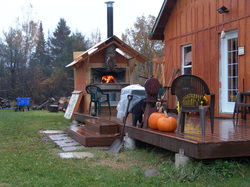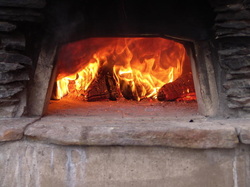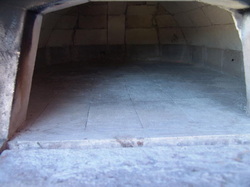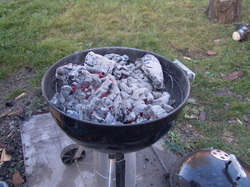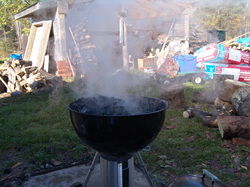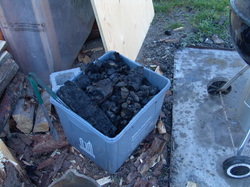Baking with an outdoor wood fired oven is pretty much the oldest form of cooking with technology. An open fire would be where it all started but then "high technology" came along and some bright person decided to cover the fire with something thick and heavy like dirt and clay. We've been baking bread in a retained heat oven for over 5,000 years. It's only in the last couple of hundred years that that has changed appreciably. Fortunately there is a growing population of people who can see and taste the difference of bread cooked the "old" way, particularly if the breads are fermented with a sourdough.
What I describe below is an every day routine for me; firing up the oven early in the morning and managing the retained heat for cooking.
I put a fire in the oven every day whether we are baking that day or not. On the off days I want to keep the temperature up so it doesn't take too long to heat the mass. I'm averaging about a 4 hour burn each day. I would suspect it would take a full day or more to bring the oven mass to a working temperature from a cold start.
What I describe below is an every day routine for me; firing up the oven early in the morning and managing the retained heat for cooking.
I put a fire in the oven every day whether we are baking that day or not. On the off days I want to keep the temperature up so it doesn't take too long to heat the mass. I'm averaging about a 4 hour burn each day. I would suspect it would take a full day or more to bring the oven mass to a working temperature from a cold start.
6:00 am
Yupe, it's dark at this time of morning in October. I enjoy it though since I'm an early riser anyways.
Get up, check the woodstove inside, feed the cats, make coffee and then go out and start the fire. The oven is general around 250 - 300 degree F. from the previous day. I don't have to be fussy about the wood I use, provided it's clean. Meaning no plywood, mdf or other toxic stuff. Once it's started, the coffee will be ready and I can sit with a cup of coffee and watch the day begin. |
8:30 am
It was a dark and stormy night... oh, wait.
It was much brighter and just a bit of rain and the fire was well started. Since the oven door faces the county road we live on those who drive by can see we are indeed still alive and getting ready for another day. Many of the regulars wave and honk as they go by. |
9:00 am
The fire is going great now although not quite up to full temperature. You can tell the fire is really cooking when the coals get a very bright, sparkly look.
You can't see it in the photo but this is a good time to see how the air flow works so well with the shape the dome is. Air is drawn in at the bottom of the door; indicated by small bits of burning wood near the door with smoke flowing into the oven. While at the top of the door smoke and sometimes flames pour out and up the chimney. By this time I will determine if there needs to be more wood added or this will be enough and I can let this burn down till it is time to clean the oven out and close it. |
10:00 am
I didn't need to add any more wood this time and now I'm setting up to pull the remaining coals out and cleaning the oven.
Debbie and I discuss when we would like to start baking, usually between 3 and 4 pm, and I then attempt to get the oven ready around that time. We tend to bake very hot; above 500 degrees F to begin with for our ciabatta, rye bread and 3 seed. This is all a trial and error process that has taken a few months to get a good "feel" for what the oven needs. |
10:30 am
I've pulled the remaining coals forward and use a shovel to scoop them out.
Then I wash the hearth with a rag on the end of a stick. I had thought cleaning the ashes out would be a nuisance, but it is very easy. So, the oven is nice and clean and over 700 degrees F. My laser thermometer doesn't read over 600 degrees so how do I know it is more than that? Looking at the pictures you can see the individual bricks in the dome, this indicates that the soot and ash on the bricks is transparent. Ash goes transparent when over 700 degrees. Part of the process of the burn is to hold the fire at a vigorous level, above 700 degrees so that lots of heat penetrates into the surrounding firebrick and concrete. I close the door now and start the "soak" phase, whereby the heat is allowed to soak into the concrete and become evenly distributed. We are finding the heat in the oven to be very even throughout. However I do have to pay particular attention to getting the front of the oven, nearest the door, well heated. Due to the shape of the dome the concrete around and above the door is the thickest and thus takes the longest to heat up. |
Harvesting charcoal.
So, what did I do with the coals from the oven. Well, until we actually put bread in the oven what we have is a large charcoal makers. Being of Scottish decent I have a hard time wasting things.
I use my weber barbecue to harvest the coals. Shoveling the coals onto the weber, with the waste water that I washed out the oven with used to douse the coals. I put the lid on the barbi and let the steam do its thing. Once the coals are dry they go inside to help keep the house warm. There's another reason for going to what may seem like a bunch of trouble. We generate quite a bit of charcoal and it has to go someplace, yet charcoal doesn't break down (or at least not that quickly) so it's not much good for our gardens. The ash though is very good. The ash is washed off the charcoal and that will go in the garden. the coals get a second chance to burn completely, in the house woodstove, and then that ash is put on the garden. The above paragraph was written in 2011. In 2013 I'm exploring the notion of creating bio-char with the charcoal. We have a substantial garden that will continually need compost and now perhaps bio-char. This shouldn't be a great deal of extra work, we are already generating the charcoal and just need to have some barrels where I can mix it with water and compost.
|
Heat loss:
The outside of the mass of concrete, and the concrete hearth averages around 140 degrees F when the oven is up to temperature. This heat will obviously dissipate and will get much worse when a wind is blowing. I put a structure around the oven to keep the wind off and I also insulated it with scraps of insulation I had.
Heat is lost through the open door, particularly when loading and unloading bread. Bigger, professional ovens have an mechanical system to open the door "hands-free". For poor smucks like me I just work quickly with one hand managing the door and the other holding the peel.
The largest heat loss is from the bread itself. This is an aspect that I've not seen mentioned in any of the works I've read. Perhaps it is simply assumed that people will understand that a lot of heat is lost with the baking process. Perhaps this is true but I wanted to cover this is in a bit more detail.
If I put a load of say 12 loaves of bread in the oven I will notice an immediate drop in temperature, generally about 25 to 50 degrees. It takes the oven a little while to regenerate and come back up to its current stable temperature. This is why we tend to bake much hotter than a recipe will call for.
The heat that is lost at this stage is just that used to bring the bread up to the ambient oven temperature.
A second stage of heat loss is a bit more technical and has to do with the "change in state" of the water. To keep this simple for us, a change in state of water means for example changing ice to water, without a change in temperature. Thus, changing ice at 32 degrees F to water at 32 degrees F.
The energy required to do this is measured in heat units and to change a pound of ice to a pound of water takes 135 heat units. I won't get into what heat units are being used, it's not that important.
What is important is changing a pound of water into steam, which takes 966 heat units.
So,
ice to water = 135 heat units
water to steam = 966 heat units.
Quite the difference and when we are baking bread there is a considerable amount of water converted to steam. Not only are we talking about the water that is in the bread but also the water that is sprayed into the oven to add extra steam to help with oven spring and keep the crust thin and crispy.
A very useful aspect of spraying water into the oven is that this can be used to quickly cool the oven down to a temperature nearer to what you may want. I've used this technique particularly when our breads have worked quicker than anticipated and I needed to cool the oven. I can quite quickly bring the temperature down 50 degrees.
Then of course there is a bunch of heat carried out of the oven when we bring our lovingly baked bread out for the hordes of salivating clients.
The numbers and technical jargon are not that important and I've played fast and loose with the terms, (I didn't describe what heat unit I meant). I simply wanted to point out the areas where heat is "consumed" in the baking process which should help you understand and anticipate your oven performance.
Heat is lost through the open door, particularly when loading and unloading bread. Bigger, professional ovens have an mechanical system to open the door "hands-free". For poor smucks like me I just work quickly with one hand managing the door and the other holding the peel.
The largest heat loss is from the bread itself. This is an aspect that I've not seen mentioned in any of the works I've read. Perhaps it is simply assumed that people will understand that a lot of heat is lost with the baking process. Perhaps this is true but I wanted to cover this is in a bit more detail.
If I put a load of say 12 loaves of bread in the oven I will notice an immediate drop in temperature, generally about 25 to 50 degrees. It takes the oven a little while to regenerate and come back up to its current stable temperature. This is why we tend to bake much hotter than a recipe will call for.
The heat that is lost at this stage is just that used to bring the bread up to the ambient oven temperature.
A second stage of heat loss is a bit more technical and has to do with the "change in state" of the water. To keep this simple for us, a change in state of water means for example changing ice to water, without a change in temperature. Thus, changing ice at 32 degrees F to water at 32 degrees F.
The energy required to do this is measured in heat units and to change a pound of ice to a pound of water takes 135 heat units. I won't get into what heat units are being used, it's not that important.
What is important is changing a pound of water into steam, which takes 966 heat units.
So,
ice to water = 135 heat units
water to steam = 966 heat units.
Quite the difference and when we are baking bread there is a considerable amount of water converted to steam. Not only are we talking about the water that is in the bread but also the water that is sprayed into the oven to add extra steam to help with oven spring and keep the crust thin and crispy.
A very useful aspect of spraying water into the oven is that this can be used to quickly cool the oven down to a temperature nearer to what you may want. I've used this technique particularly when our breads have worked quicker than anticipated and I needed to cool the oven. I can quite quickly bring the temperature down 50 degrees.
Then of course there is a bunch of heat carried out of the oven when we bring our lovingly baked bread out for the hordes of salivating clients.
The numbers and technical jargon are not that important and I've played fast and loose with the terms, (I didn't describe what heat unit I meant). I simply wanted to point out the areas where heat is "consumed" in the baking process which should help you understand and anticipate your oven performance.
Re-firing the oven in the even.
As mentioned above, before starting a fire in the morning, the oven is still around 250 - 300 F from the previous day's bake.
Since our breads get baked in the late afternoon for the most part people buy bread the next day when the bread has cooled. This is a good thing for our sourdough breads since for best results they need to rest and cool down, do as to fully develop a good flavour and structure, before you cut into them.
Yet, customers do like food, warm, just out of the oven and we've been thinking of what we can bake first thing in the morning. Since the oven is quite warm already in the morning, but not quite warm enough, I've started to put a small fire in the oven in the evening after our baking is done. What I do is put a good fire in and let it burn down, then while the coals are still hot I close the oven up.
In the morning some of the coals will still be glowing when I open the oven again. What I'm aiming for is to have the oven around 400 - 450 F at 5:30am. This provides good heat for baking croissants and scones; and this has been a nice addition. We can have fresh baked croissants ready at 6:00 am and since the oven is hotter I don't loose any time with firing the oven to the day.
Since our breads get baked in the late afternoon for the most part people buy bread the next day when the bread has cooled. This is a good thing for our sourdough breads since for best results they need to rest and cool down, do as to fully develop a good flavour and structure, before you cut into them.
Yet, customers do like food, warm, just out of the oven and we've been thinking of what we can bake first thing in the morning. Since the oven is quite warm already in the morning, but not quite warm enough, I've started to put a small fire in the oven in the evening after our baking is done. What I do is put a good fire in and let it burn down, then while the coals are still hot I close the oven up.
In the morning some of the coals will still be glowing when I open the oven again. What I'm aiming for is to have the oven around 400 - 450 F at 5:30am. This provides good heat for baking croissants and scones; and this has been a nice addition. We can have fresh baked croissants ready at 6:00 am and since the oven is hotter I don't loose any time with firing the oven to the day.

